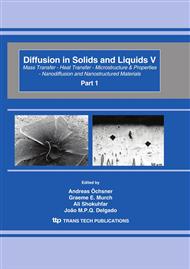p.1322
p.1328
p.1334
p.1340
p.1346
p.1354
p.1362
p.1371
p.1377
Diffusion Phenomena of the Oxygen and Nitrogen in Niobium by Mechanical Spectroscopy
Abstract:
The short-range diffusion phenomenon (Snoek Effect) was investigated by mechanical spectroscopy measurements between 300 K and 650 K, in a polycrystalline niobium sample, containing oxygen and nitrogen, using a torsion pendulum. Experimental spectra of anelastic relaxation were obtained under three conditions: as-received sample; annealed sample and subsequently annealed in an oxygen atmosphere for three hours at 1170 K in partial pressure of 5x10-5mbar. The experimental spectra obtained were decomposed in elementary Debye peaks and the anelastic relaxation processes were identified. With anelastic relaxation parameters and the lattice parameters, the interstitial diffusion coefficients of the oxygen and nitrogen in niobium were calculated for each kind of preferential occupation (octahedral and tetrahedral). The results were compared with the literature data, and confirmed that the best adjustment is for the preferential occupation octahedral model for low concentrations of interstitial solutes, but at higher concentration of oxygen were observed deviations of experimental data for the interstitial diffusion coefficients of oxygen in niobium when compared with the literature data, this could be related to the possible occurrence of a double occupation of interstitial sites in the niobium lattice by oxygen interstitials.
Info:
Periodical:
Pages:
1346-1353
Citation:
Online since:
April 2010
Keywords:
Price:
Сopyright:
© 2010 Trans Tech Publications Ltd. All Rights Reserved
Share:
Citation:


